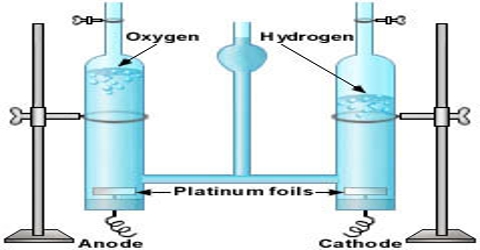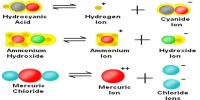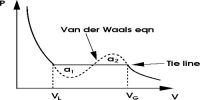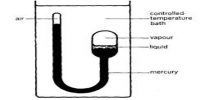Hofmann’s method
In this method, a known mass of the liquid is allowed to evaporate in the vacuous space above the mercury column in a barometer. The pressure and volume of the vapor are noted and the molecular mass calculated from these data.
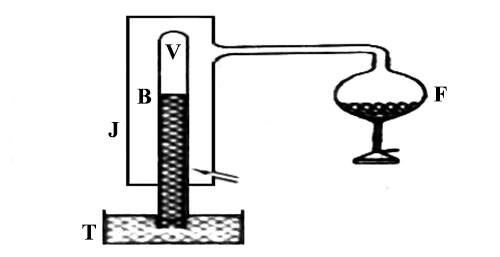
Fig: Hofmann’s apparatus
The apparatus is shown diagrammatically in Figure. The graduated barometer tube, B, about one meter long and filled with pure mercury, is inserted over a trough of mercury, T, with its end below the mercury level in T. Mercury stands at a height corresponding to the atmospheric pressure. The space, V, above the mercury level in the tube is the Torricellian vacuum. The barometer tube is surrounded by a jacket, J. through which not vapor from the liquid boiling in the flask, F, may be passed so as to keep the space V at the desired temperature.
A small bottle fitted with a ground stopper called Hofmann’s bottle, or a small bulb with a neck drawn out into a fine capillary is dried and filled with about 0.1 g – 0.2 g of the liquid. The mass of the liquid should be accurately known.
The height of mercury level is noted and the bottle or bulb is introduced into space, V, simply by holding it at the open end of the tube below mercury level, as mercury is much denser than the bulb. The liquid in the bulb evaporates or hot vapor may be passed through the heating jacket to facilitate evaporation. The pressure of the vapor will depress the mercury level and when the new level has become steady the height of mercury level and the temperature in the jacket are noted. The difference of mercury levels before and after the introduction of the vapor is the pressure of the vapor. Since the volume of the vapor may be easily read off from the graduation in the tube and the mass of the liquid introduced is known, the density and hence the molecular mass of the vapor may be calculated.
Accurate results may be obtained with this method but the apparatus is cumbersome and difficult to arrange. Another disadvantage is that the method cannot be used for determining densities above 2500C because of the volatility of mercury above this temperature. Correction for vapor pressure of mercury has to be applied for measurements above 100°C
